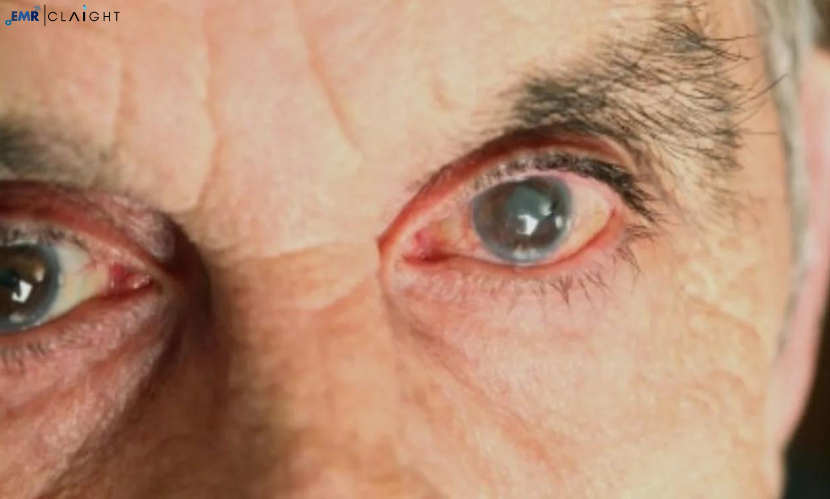Global Age-Related Macular Degeneration (AMD) Market: Growth, Trends, & Key Players | 2024 – 2032
The global age-related macular degeneration (AMD) market stood at USD 2.04 billion in 2023 and is projected to reach USD 4.40 billion by 2032, growing at a CAGR of 8.9% between 2024 and 2032. The increasing prevalence of AMD, coupled with advancements in treatment and growing awareness, are key drivers behind this impressive market growth.
Introduction
Age-related macular degeneration (AMD) is one of the leading causes of vision loss in people aged 50 and above. The disease affects the macula, a small part of the retina responsible for sharp central vision. With the aging global population, the demand for effective AMD treatments has surged, contributing to significant growth in the market. In this article, we will explore the key factors driving the AMD market, major players shaping the industry, and the trends that will influence its trajectory in the coming years.
Overview of Age-Related Macular Degeneration (AMD)
AMD is classified into two types: dry AMD (non-neovascular) and wet AMD (neovascular). Dry AMD, the more common form, progresses slowly and is characterized by the thinning of the macula. Wet AMD, on the other hand, is more severe and results from abnormal blood vessel growth in the retina. Though less common, wet AMD accounts for a greater proportion of vision loss cases.
Market Dynamics
Drivers of Market Growth
- Aging Population: With increasing life expectancy, the global elderly population is rapidly growing. AMD predominantly affects older adults, and the rising number of individuals aged 60 and above is a major driver of the market.
- Technological Advancements in Treatment: Continuous advancements in the treatment of AMD, including anti-VEGF therapies (vascular endothelial growth factor inhibitors) and gene therapies, have revolutionized the market. These innovations have made treatment more effective, reducing the rate of vision loss in patients and prolonging the quality of life.
- Growing Awareness and Early Diagnosis: Public health initiatives and campaigns aimed at spreading awareness about AMD have led to earlier detection of the disease. Early diagnosis improves treatment outcomes, thus increasing the demand for diagnostic tools and therapies.
- Increase in Healthcare Expenditure: Governments and private sectors across the globe are increasing their healthcare budgets, focusing on improving treatments for chronic conditions such as AMD. This rise in healthcare expenditure is contributing to market growth.
Restraints
- High Cost of Treatments: One of the primary barriers to market expansion is the high cost associated with AMD treatments, especially newer therapies like anti-VEGF injections. This limits access to treatments for patients in low-income regions, hindering market growth.
- Limited Availability in Underdeveloped Regions: In low-income and underdeveloped regions, there is limited access to advanced AMD treatments due to inadequate healthcare infrastructure and low awareness. This has resulted in underdiagnosis and undertreatment of the disease in certain populations.
Trends Shaping the AMD Market
- Emerging Role of Gene Therapy: Gene therapy is an emerging treatment for AMD, with several clinical trials showing promising results. The ability to modify genetic material to correct or halt the progression of AMD could drastically change the future landscape of treatment.
- Introduction of Biosimilars: With the expiration of patents for several blockbuster AMD drugs, biosimilars are expected to enter the market. These alternatives offer similar efficacy at lower costs, making treatment more accessible and driving market competition.
- Increasing Focus on Home-Based Diagnostics: In light of the COVID-19 pandemic and the growing trend toward telemedicine, there has been a surge in the development of home-based diagnostic devices for AMD. This enables early detection and continuous monitoring, contributing to better treatment outcomes.
- Combination Therapies: Combination therapies that integrate different treatment modalities, such as anti-VEGF injections with gene therapy or stem cell treatment, are becoming more common. This approach can target multiple aspects of AMD progression, improving overall treatment efficacy.
Market Segmentation
The global age-related macular degeneration market can be segmented based on product type, stage, distribution channel, and region.
1. By Product Type
- Anti-VEGF Drugs: These are the most common treatments for wet AMD. Drugs like Ranibizumab (Lucentis), Bevacizumab (Avastin), and Aflibercept (Eylea) are widely used to inhibit the abnormal growth of blood vessels in the retina.
- Gene Therapy: Gene therapy is still in the experimental stage, but it holds significant promise for addressing the underlying genetic causes of AMD.
- Laser Therapy: Laser treatments, though less commonly used today due to advancements in pharmacotherapy, are still an option for some AMD patients.
- Nutritional Supplements: Supplements such as antioxidants, lutein, and zeaxanthin are recommended for the prevention of dry AMD progression.
2. By Stage
- Early-Stage AMD: Characterized by minor vision impairment, patients with early-stage AMD may not show significant symptoms, but monitoring and preventative care are important.
- Intermediate-Stage AMD: Patients begin to show signs of vision deterioration, and treatments focus on slowing disease progression.
- Late-Stage AMD: In this stage, vision loss is more pronounced, particularly in wet AMD cases, where treatments like anti-VEGF therapies are most commonly used.
3. By Distribution Channel
- Hospitals and Clinics: Hospitals remain the primary distribution channel for AMD treatments due to the need for specialized care.
- Retail Pharmacies: With increasing access to prescription drugs, retail pharmacies play a key role in distributing AMD treatments.
- Online Pharmacies: The rise of e-commerce has enabled patients to purchase prescription medications online, offering convenience and often reduced costs.
4. By Region
- North America: The North American AMD market is well-established, driven by high healthcare spending and early adoption of new technologies.
- Europe: Europe holds a significant share of the global AMD market due to its aging population and strong healthcare infrastructure.
- Asia-Pacific: This region is expected to witness significant growth, driven by rising healthcare awareness and improvements in medical facilities, especially in countries like China and India.
- Rest of the World: Markets in regions such as Latin America, the Middle East, and Africa remain underdeveloped but have the potential for future growth as healthcare systems improve.
Key Players in the Age-Related Macular Degeneration Market
Several key players dominate the AMD market, contributing to its rapid growth. These companies are at the forefront of innovation, developing advanced treatments and expanding market access.
1. Regeneron Pharmaceuticals, Inc.
Regeneron is a leading biotechnology company and a key player in the AMD market with its flagship product, Eylea (Aflibercept). Eylea is one of the most widely used anti-VEGF drugs for treating wet AMD. Regeneron has consistently focused on expanding its reach across global markets and continues to invest heavily in research and development.
2. Roche Holding AG (Genentech)
Roche, through its subsidiary Genentech, has developed Lucentis (Ranibizumab), another widely used anti-VEGF therapy for AMD. The company is also exploring new treatment options and combination therapies to improve patient outcomes. Genentech’s innovative approach to AMD treatment has placed Roche as one of the top players in this sector.
3. Novartis AG
Novartis, in collaboration with Roche, is responsible for the global marketing of Lucentis. The company has also been active in developing gene therapy solutions for AMD and continues to explore new avenues in personalized medicine to target this condition.
4. Bayer AG
Bayer AG is a key player in the AMD market, co-developing Eylea with Regeneron. The company has expanded its presence in the global market by marketing Eylea in various regions. Bayer’s focus on precision medicine and biotechnology aligns with the growing demand for personalized AMD treatments.
5. Allergan (AbbVie)
Allergan, now a part of AbbVie, has made significant contributions to the AMD market, particularly with its focus on combination therapies and innovative drug delivery systems. AbbVie continues to invest in research to advance AMD treatment options and improve patient outcomes.
6. Opthea Limited
Opthea is an emerging player in the AMD market, focused on developing next-generation therapies for wet AMD. The company’s lead product candidate, OPT-302, is currently in clinical trials and shows promise in providing more effective treatments for AMD patients who do not respond well to traditional anti-VEGF therapies.
Recent Developments in the AMD Market
- Advancements in Gene Therapy: Recent progress in gene therapy has shown promising results in treating the underlying genetic causes of AMD. Companies like Regenxbio are at the forefront of developing gene therapies aimed at halting the progression of the disease.
- Introduction of Biosimilars: With the expiration of patents for several anti-VEGF therapies, biosimilars are beginning to enter the market. These lower-cost alternatives are expected to increase accessibility to AMD treatments, particularly in developing regions.
- AI in AMD Diagnosis: Artificial intelligence (AI) is being integrated into diagnostic tools to improve early detection of AMD. AI algorithms can analyze retinal images with high accuracy, enabling earlier and more accurate diagnoses.
- Wearable Diagnostic Devices: Companies are developing wearable devices that allow patients to monitor their eye health at home, providing real-time data to healthcare providers for more personalized treatment plans.
COVID-19 Impact on the AMD Market
The COVID-19 pandemic had a significant impact on the global AMD market. During the early stages of the pandemic, many patients delayed or missed regular eye check-ups, leading to an increase in the number of advanced AMD cases. However, the market quickly adapted, with telemedicine and remote diagnostics playing a more significant role in patient care. Pharmaceutical companies also accelerated the development of at-home treatment options, ensuring that patients could continue their therapies despite the restrictions.
The pandemic underscored the importance of early diagnosis and regular monitoring for AMD, and the industry responded by fast-tracking innovations in telemedicine, AI diagnostics, and remote care solutions.
FAQ
Q1: What is age-related macular degeneration (AMD)?
A1: AMD is a progressive eye disease that affects the macula, leading to vision loss in people aged 50 and above. It is a leading cause of vision impairment in older adults.
Q2: What are the current treatments for AMD?
A2: The most common treatments for AMD include anti-VEGF injections, laser therapy, gene therapy (in experimental stages), and nutritional supplements for prevention.
Q3: Which companies are leading the AMD market?
A3: Major players in the AMD market include Regeneron Pharmaceuticals, Roche (Genentech), Novartis, Bayer AG, and AbbVie (Allergan).
Q4: How is the AMD market expected to grow in the coming years?
A4: The global AMD market is projected to grow at a CAGR of 8.9% from 2024 to 2032, reaching USD 4.40 billion by 2032, driven by technological advancements and an aging global population.
Q5: What impact did COVID-19 have on the AMD market?
A5: COVID-19 led to disruptions in regular eye care visits and treatments, but the market adapted through telemedicine and remote diagnostics, ensuring continued patient care.
About Us
Acquire unparalleled access to critical industry insights with our comprehensive market research reports, meticulously prepared by a team of seasoned experts. These reports are designed to equip decision-makers with an in-depth understanding of prevailing market trends, competitive landscapes, and growth opportunities.
Our high-quality, data-driven analysis provides the essential framework for organisations seeking to make informed and strategic decisions in an increasingly complex and rapidly evolving business environment. By investing in our market research reports, you can ensure your organisation remains agile, proactive, and poised for success in today’s competitive market.
Don’t miss the opportunity to elevate your business intelligence and strengthen your strategic planning. Secure your organisation’s future success by acquiring one of our Expert Market Research reports today.
Media Contact
Company Name: Claight Corporation
Contact Person: James william, Corporate Sales Specialist
Email: sales@expertmarketresearch.com
Toll Free Number: +1-415-325-5166 | +44-702-402-5790
Address: 30 North Gould Street, Sheridan, WY 82801, USA
Website: www.expertmarketresearch.com






